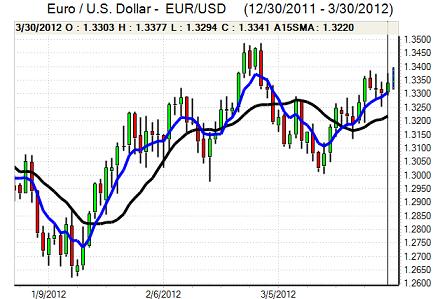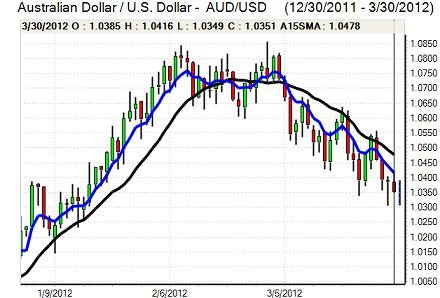EUR/USD
The Euro maintained a generally solid tone on Friday with evidence of some support from quarter-end positioning. Euro-group ministers agreed an EU firewall increase to EUR700mn for the net lending limit with a combination of the EFSF and ESM during the 12 months from July 2012, although new funds available will be significantly lower given the funds already committed.
As expected, Spain announced an additional EUR27bn in spending cuts and tax increases in order to bring the budget deficit back to the target level with the deficit projected at 5.3% of GDP for 2012. There was still a high degree of scepticism surrounding the Spanish economic situation, especially with the economy trapped in recession which would undermine revenue targets.
The revised US Michigan consumer confidence data was slightly stronger than expected with a rise to 76.2 from a provisional 74.3 while the latest personal spending data was also slightly stronger than expected. In contrast, the Chicago PMI index was slightly weaker than expected at 62.2 for the month from 64.0 previously.
Regional Fed President Lacker stated that there was no need for additional quantitative easing, although the impact was limited. The Euro found support on dips towards the 1.33 area ahead of the US open and rallied back towards 1.3360.
The latest IMM positioning data recorded a sharp increase in dollar longs to the highest level since January which will make it difficult for the US currency to make significant headway. The Euro pushed to highs near 1.3380 in early Asia on Monday before edging lower as activity declined after an initial surge.

Source: VantagePoint Intermarket Analysis Software
Call now and you will be provided with FREE recent forecasts
that are up to 86% accurate* 800-732-5407
If you would rather have the recent forecasts sent to you, please go here
Yen
The dollar found support in the 82 area against the yen during Friday and gained steadily during the US session with a peak above 82.80. There was a decline in defensive yen demand on safe-haven grounds and there was also a reduction in capital repatriation flows following the end of the fiscal year which helped push the US currency higher. There was also speculation that investment funds would push flows out of Japan at the start of the new fiscal year.
The yen also dipped weaker in Asian trading on Monday following the stronger than expected Chinese PMI data. The latest options data recorded a sharp increase in dollar sell calls which will tend to make it more difficult for the US currency to make headway.
The Tankan business confidence index was unchanged for the second quarter, in contrast to expectations for an increase and the weaker than expected outcome increased speculation that the Bank of Japan could act to loosen monetary policy further and the dollar pushed to highs above 83.
Sterling
Sterling maintained a strong tone in the European session on Friday and continued to challenge resistance levels above 1.60 which was a 20-week high for the UK currency. Technical considerations remained important as markets probed long-term resistance levels.
There were still concerns surrounding the potential for additional quantitative easing following a run of generally less favourable data and the currency struggled to hold the advance. The PMI data will be watched very closely over the first three days of the week for evidence of underlying trends. If there is a series of weak releases, pressure for the central bank to act again will intensify.
There was a small increase in the monthly Hometrack house-price index for March, but there were expectations that the ending of tax reliefs would trigger a reversal for April. Sterling again found it difficult to hold above 1.60 in Asian trading on Monday.
Swiss franc
The dollar was unable to make much headway on Friday an dipped to lows near 0.90 in Asian trading on Monday before stabilising. Principal attention focused on the Euro as it dipped to lows below 1.2040 which was the weakest level since September, shortly after the 1.20 minimum Euro level had been put in place.
The KOF index was stagnant just above the zero level for the month which did not have a major impact, although it will maintain some degree of pressure for the National Bank to weaken the Swiss currency, especially if there is a weak PMI release for the month and their actions will be watched very closely over the next 24 hours.

Source: VantagePoint Intermarket Analysis Software
Call now and you will be provided with FREE recent forecasts
that are up to 86% accurate* 800-732-5407
If you would rather have the recent forecasts sent to you, please go here
Australian dollar
The Australian dollar remained on the defensive during Friday and retreated back to the 1.0350 region later in the US session. The local currency jumped higher in early Asian trading on Monday as it received a big boost from a much stronger than expected official Chinese PMI reading which increased confidence surrounding commodity exports.
The domestic data was weaker than expected with a sharp 7.8% decline in building approvals for March which had a significant impact in dampening the mood of optimism and the currency retreated to test support below the 1.04 level.



